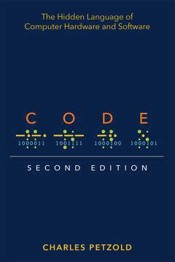Code: The Hidden Language of Computer Hardware and Software

This book started so well, but then it got way more in-depth than I wanted to get, and it ultimately lost me.
This is a book about how computers work. Literally how the computer thinks. The author starts off with basic codes, like Morse Code, explaining how more complex concepts can be made from simple structures.
He then moves through things like Base X numbering and explains why we use Base 10, whereas cartoon characters would use Base 8 and dolphins would use Base 2 (it’s based on the number of digits you have to count with). He explains bits and bytes, and then moves into text encodings like Unicode.
About halfway through the book, he gets into logic gates and relays. I stuck with him through the start of this, but then he went way, way into the weeds on how to do addition with logic gates. He literally shows you how to build a calculator and a clock with nothing but binary logic gates.
This stuff is complicated, in a really tedious way. I got worn down trying to follow the different logic controls. There are so many diagrams. It gets so complicated, that the author built a website for the second edition, complete with interactive circuit diagrams.
When he started to drift into hardware, I just got confused and lost interest. I don’t need to know how a CPU works or how memory chips store data. That’s just not helpful to me, and he got so detailed on it. I could have taken a high-level summary.
I skipped through a few chapters, but it didn’t seem like he was going to come back from that abyss, so abandoned it. I did enjoy the first half of the book, though. I learned a lot. It was worth it for that alone.
Book Info
- I have read this book. According to my records, I completed it on .
- A softcover copy of this book is currently in my home library.